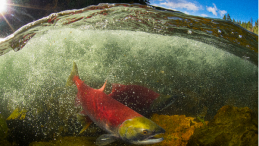Discovery Islands Salmon Farms to Close
Minister's decision on salmon farm licences spells hope for Fraser Sockeye
VANCOUVER: Fisheries Minister Bernadette Jordan issued a decision today that may reverse the rapdily declining trend of Fraser River salmon stocks, including the commercially important sockeye and the endangered Chinook salmon relied on by Southern Resident Killer Whales. Wild salmon advocates at Living Oceans Society say the decision to keep salmon farms in the Wild Salmon Narrows (Discovery Islands) near Campbell River fallow means more wild salmon may avoid death from lice and disease pathogens proliferating around open net-pen salmon farms.
"The federal government has spent hundreds of millions of dollars to bypass the Big Bar landslide, ensuring fish can access the Fraser’s spawning grounds. It was essential that the Wild Salmon Narrows be cleared of farms, to allow the tiny smolts emerging from the river to make their way to sea without being decimated by lice and disease pathogens coming from fish farms," said Executive Director Karen Wristen.
The sockeye emerging in the spring of next year will be the offspring of a run that was, when it returned to spawn, the smallest in the history of Canadian sockeye records. DFO Fisheries habitat scientists reviewing the chances of survival of some of the Fraser's most endangered populations have stressed that "all sources of harm must be reduced to the greatest extent possible".
"Knowing that virtually all of the sockeye (99%) that passed through the Wild Salmon Narrows' gauntlet of salmon farms in 2020 were infected with a lethal load of salmon lice, the only responsible course of action was to ensure that the industry there is all shut down before the beginning of the next outmigration in March", said Wristen. This decision will allow some farms to continue to operate through the outmigration, but at least provides a single, farm-free route for sockeye to take. "Some of the smolts will no doubt take that route. Others will still be subject to the lice and pathogens flowing out of the farms."
The parent generation (2019) of the juveniles that will migrate out of the river in 2021 numbered only about 500,000 fish. This is the third-largest of the four-year cycle of sockeye, with an average return (1951-2011) of 5.3 million fish. It seemed that disaster struck this salmon cycle in 2015, when only 2 million of a predicted 6 million fish returned.
"It is clear that Fraser sockeye are on a rapid path toward extirpation," Wristen commented. "They can recover, as they did after the 1914 Hells Gate landslide that decimated all four years of the cycle. Their numbers rebuilt steadily through subsequent decades, even under pressure from fishing, loss of habitat and warming waters. They can do that again, but only if we stop the catastrophic losses of juvenile salmon that are happening because of salmon farming."
-30-
Photo Credit: Tavish Campbell Coastal Photography
-30-
Contact Information
Karen Wristen, Executive Director 604-788-5634 kwristen at livingoceans.org

